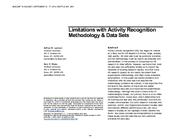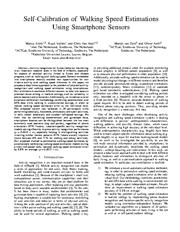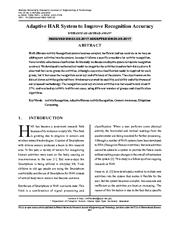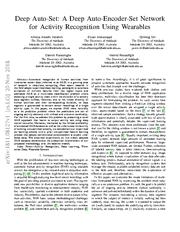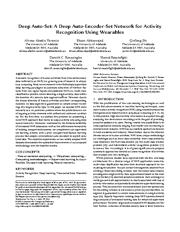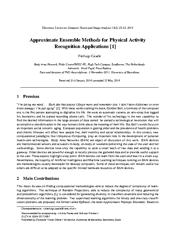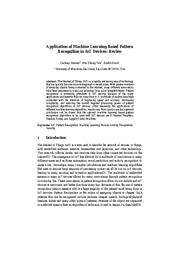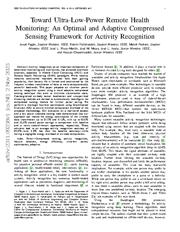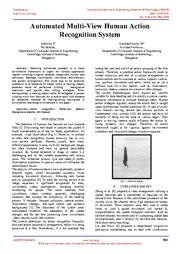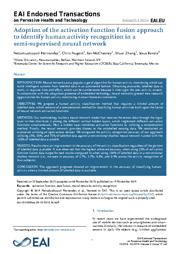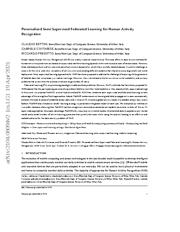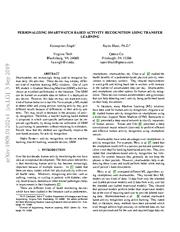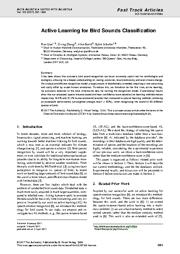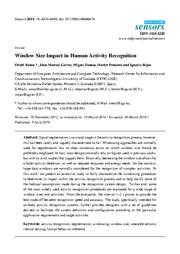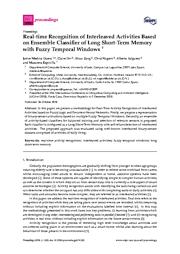A copy of this work was available on the public web and has been preserved in the Wayback Machine. The capture dates from 2017; you can also visit the original URL.
The file type is application/pdf.
Filters
Limitations with activity recognition methodology & data sets
2014
Proceedings of the 2014 ACM International Joint Conference on Pervasive and Ubiquitous Computing Adjunct Publication - UbiComp '14 Adjunct
Human activity recognition (AR) has begun to mature as a field, but for AR research to thrive, large, diverse, high quality, AR data sets must be publically available and AR methodology must be clearly ...
In this paper we outline problems and limitations with AR data sets and describe the methodology problems we noticed, in the hope that this will lead to the creation of improved and better documented data ...
the diversity of the data set and/or methodological limitations. ...
doi:10.1145/2638728.2641306
dblp:conf/huc/LockhartW14
fatcat:l7rwsvpbczgxtdmntwmovn5y5m
Self-calibration of walking speed estimations using smartphone sensors
2014
2014 IEEE International Conference on Pervasive Computing and Communication Workshops (PERCOM WORKSHOPS)
Additionally, we introduce a novel automatic calibration methodology combining accelerometer and GPS data while walking in unconstrained settings, in order to reduce walking speed estimation error at the ...
In this paper, we propose a data fusion approach to the problem of physical activity recognition and walking speed estimation using smartphones. ...
Our methodology combines accelerometer and GPS data while walking in unconstrained settings, to adapt subject independent estimates. ...
doi:10.1109/percomw.2014.6815158
dblp:conf/percom/AltiniVHDA14
fatcat:34tcvkzbvrcghmblfdciibopiq
Adaptive HAR System to Improve Recognition Accuracy
2018
Mehran University Research Journal of Engineering and Technology
The experiments on the data of eleven activities gathered from 10 volunteers proved the usability, scalability and effectiveness of our proposed methodology. ...
In this study, we discuss an adaptive system to improve recognition accuracy. We developed a mathematical model to categorize the activities based on their data pattern. ...
Set of eleven activities were under observation to prove the usability, scalability and effectiveness of our proposed methodology. ...
doi:10.22581/muet1982.1803.03
fatcat:ufztgjurgres3jthdsauumzl6i
Deep Auto-Set: A Deep Auto-Encoder-Set Network for Activity Recognition Using Wearables
[article]
2018
arXiv
pre-print
Automatic recognition of human activities from time-series sensor data (referred to as HAR) is a growing area of research in ubiquitous computing. ...
In this paper, we express HAR more naturally as a set prediction problem where the predictions are sets of ongoing activity elements with unfixed and unknown cardinality. ...
DEEP AUTO-SET FOR HUMAN ACTIVITY RECOGNITION Here we elaborate on our novel methodology towards addressing HAR as a set prediction problem, which we refer to as the Deep Auto-Set. ...
arXiv:1811.08127v1
fatcat:ryuljwltizglbkx7pxjxy4kwyu
Deep Auto-Set
2018
Proceedings of the 15th EAI International Conference on Mobile and Ubiquitous Systems: Computing, Networking and Services - MobiQuitous '18
Automatic recognition of human activities from time-series sensor data (referred to as HAR) is a growing area of research in ubiquitous computing. ...
In this paper, we express HAR more naturally as a set prediction problem where the predictions are sets of ongoing activity elements with unfixed and unknown cardinality. ...
DEEP AUTO-SET FOR HUMAN ACTIVITY RECOGNITION Here we elaborate on our novel methodology towards addressing HAR as a set prediction problem, which we refer to as the Deep Auto-Set. ...
doi:10.1145/3286978.3287024
dblp:conf/mobiquitous/VaraminASRR18
fatcat:zjtalwqusbbpvmm47frgqucfnu
Approximate Ensemble Methods for Physical Activity Recognition Applications
2014
ELCVIA Electronic Letters on Computer Vision and Image Analysis
With these words starting his book, Gordon Bell, a luminary of the computer era, is the first person attempting to digitalize his life. ...
Some of these techniques still remain useful but others are difficult to be adapted to the specific limited hardware resources of BAN devices. ...
Particularly for motion data, a new set of features is proposed as optimal feature set for activity recognition purposes providing at the same time physical understanding to the quantities involved in ...
doi:10.5565/rev/elcvia.607
fatcat:vngrvgll5zenhha4gcdl2jb2qq
Application of Machine Learning-Based Pattern Recognition in IoT Devices: Review
[chapter]
2021
Proceedings of International Joint Conference on Computational Intelligence
A multitude of studies has been conducted with the intention of improving speed and accuracy, decreasing complexity, and reducing the overall required processing power of pattern recognition algorithms ...
algorithms to be used with IoT devices are support vector machine, k-nearest neighbor, and random forest. ...
Limitations Some limitations of the models used in human activity recognition models that were reviewed was that the models were only limited to recognize activities based on the training data set and ...
doi:10.1007/978-981-16-3246-4_52
fatcat:ipb2x4ayhberbdctmfsgp475le
Toward Ultra-Low-Power Remote Health Monitoring: An Optimal and Adaptive Compressed Sensing Framework for Activity Recognition
2018
IEEE Transactions on Mobile Computing
While recently resource constrained wearable devices have been gaining popularity, their battery life is limited and constrained by the frequent wireless transmission of data to more computationally powerful ...
This paper proposes an ultra-low power activity recognition system using a novel adaptive compressed sensing technique that aims to minimize transmission costs. ...
Thus, due to the aforementioned limitations, we will use low performance MCUs to deal with the activity recognition problem, because they are cheap, highly integrated, and low power. ...
doi:10.1109/tmc.2018.2843373
fatcat:ty2r63upsjblznektrmz22c45q
Automated Multi-View Human Action Recognition System
2020
International Journal of Engineering Research and
An extensive audit with datasets on accessible methods for distinguishing individuals in surveillance recordings is introduced in this paper. ...
Detecting individuals precisely in a visual surveillance framework is urgent for various application regions including irregular occasion recognition, human step portrayal, blockage examination, individual ...
The proposed classifier achieves higher accuracy on data sets. . ...
doi:10.17577/ijertv9is050679
fatcat:4lqcemtrn5dt3fvsn3lrdke35i
Adoption of the activation function fusion approach to identify human activity recognition in a semi-supervised neural network
2019
EAI Endorsed Transactions on Pervasive Health and Technology
We compared the activity recognition accuracy of our approach utilising 25%, 50%, and 75% of labelled data against a conventional shallow neural network trained with the 100% of labelled data available ...
CONCLUSION: The approach proposed showed an improvement in the accuracy of classifying human activity when a limited amount of labelled data is available. ...
Overall, achieving high-performance in activity recognition with limited labelled data is a challenging topic that has attracted researchers' attention in recent years [16] . ...
doi:10.4108/eai.30-10-2018.161669
fatcat:qtc73hsiifbstmidjnxfsxmjxq
Personalized Semi-Supervised Federated Learning for Human Activity Recognition
[article]
2021
arXiv
pre-print
The most effective data-driven methods for human activities recognition (HAR) are based on supervised learning applied to the continuous stream of sensors data. ...
As a major advantage, FedHAR only requires a very limited number of annotated data to populate a pre-trained model and a small number of active learning questions that quickly decrease while using the ...
This result indicates that our method continuously improves the recognition rate with a limited amount of labels provided by the users. ...
arXiv:2104.08094v2
fatcat:5vyrytls6jailcab32o7xzt5wy
Personalizing Smartwatch Based Activity Recognition Using Transfer Learning
[article]
2019
arXiv
pre-print
The GBM can be trained on available data set before it is deployed on any device. However, this data set may not represent every kind of human behavior in real life. ...
This may result in decrease in the accuracy of activity recognition. ...
recognition using wearable sensors," IEEE Fig. 6 . 6 Average increase in the accuracy of subjects in data set II[6] Charissa Ann Ronao and Sung-Bae Cho, "Human activity recognition with smartphone sensors ...
arXiv:1909.01202v1
fatcat:lwf7wfa6y5govcjgmgnadj47ze
Active Learning for Bird Sounds Classification
2017
Acta Acustica united with Acustica
To reduce this, we introduce for the first time, active learning, for automatic selection of the most informative data for training the recognition model. ...
For a robust and efficient recognition model, a large amount of labelled data is needed, requiring a time consuming and costly effort by expert-human annotators. ...
with limited data [5] . ...
doi:10.3813/aaa.919064
fatcat:ek7dk5a52nalfgy4546rirujsi
Window Size Impact in Human Activity Recognition
2014
Sensors
On the contrary, large data windows are normally considered for the recognition of complex activities. ...
The study, specifically intended for on-body activity recognition systems, further provides designers with a set of guidelines devised to facilitate the system definition and configuration according to ...
On-body or wearable activity recognition systems normally consist of a set of sensors attached to the person's body that deliver signals (data streams) of diverse modalities. ...
doi:10.3390/s140406474
pmid:24721766
pmcid:PMC4029702
fatcat:7sezc3kfnne7zg42kvurmdlqmm
Real-time Recognition of Interleaved Activities Based on Ensemble Classifier of Long Short-Term Memory with Fuzzy Temporal Windows
2018
Proceedings (MDPI)
In this paper, we present a methodology for Real-Time Activity Recognition of Interleaved Activities based on Fuzzy Logic and Recurrent Neural Networks. ...
Each classifier is configured as a Long Short-Term Memory with self-reliant detection of interleaved activities. ...
Activity recognition assists with identifying the tasks being carried out and can determine whether the occupant has any difficulties with completing tasks or daily activities [4] . ...
doi:10.3390/proceedings2191225
fatcat:vwr6yaeccrhzvcsuc7bheo2z6i
« Previous
Showing results 1 — 15 out of 541,463 results

